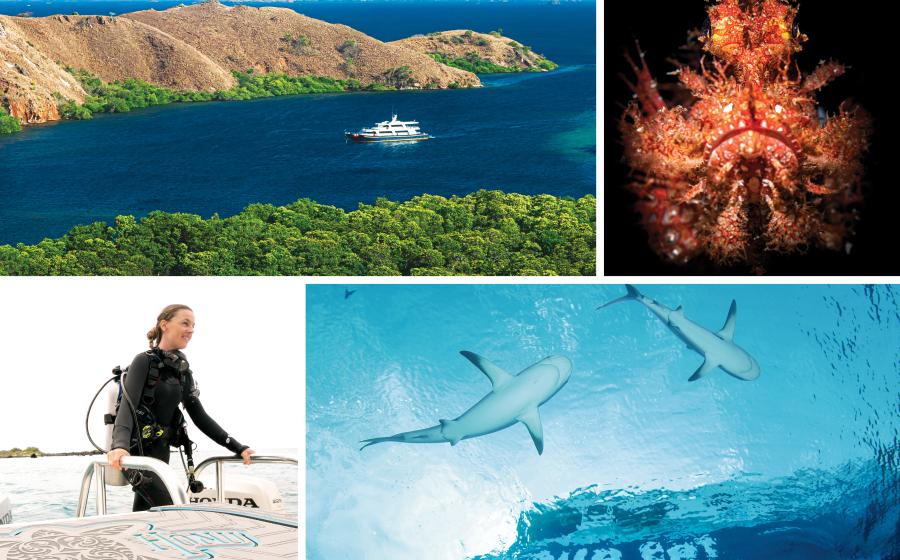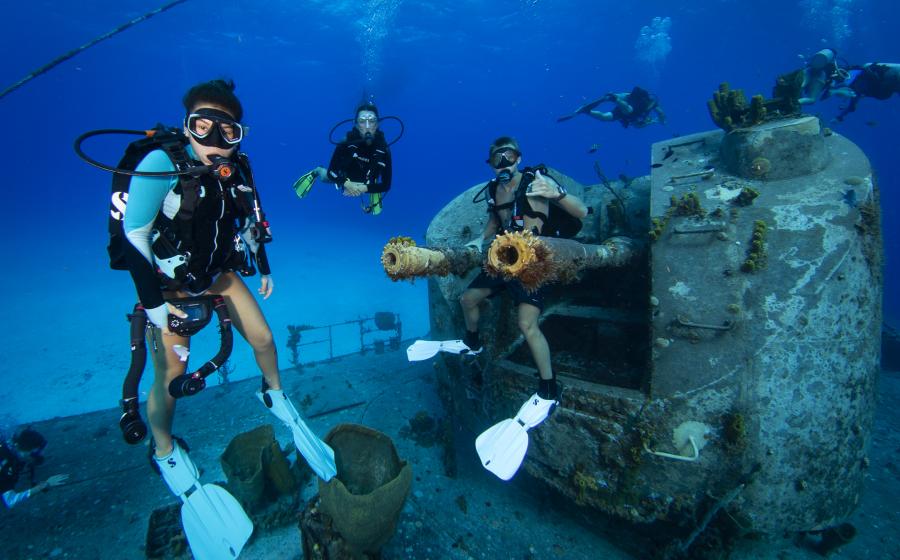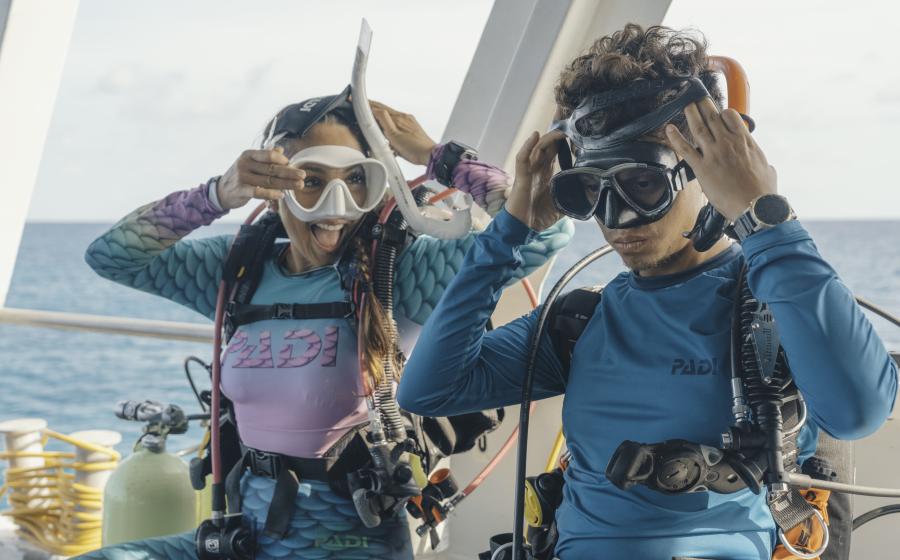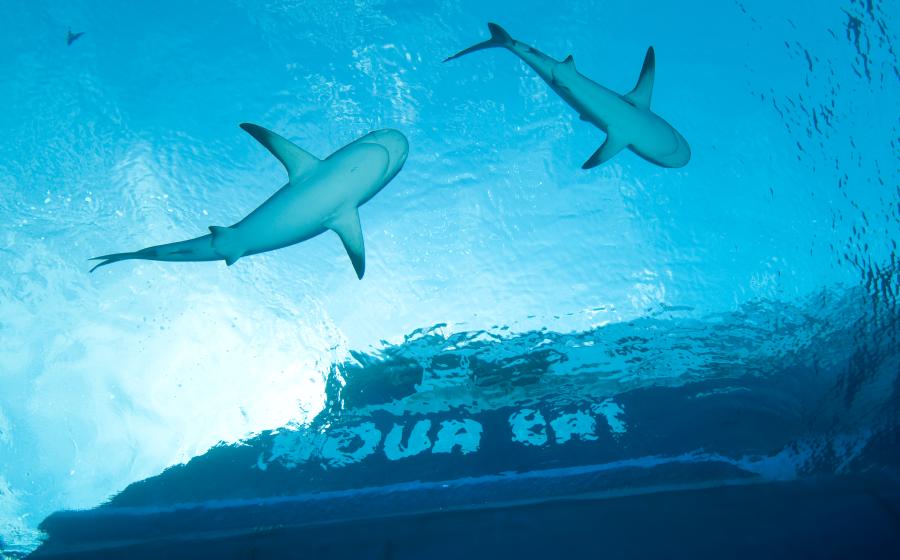The Lost World

If there’s one thing you need to know about Cocos, it’s this: The island is home to sharks — lots of them. Take your pick from packs of whitetips, squadrons of scalloped hammerheads that patrol the blue and the ubiquitous whale sharks that make any dive the best dive you’ve ever been on. If you’re not into sharks (and hey, I’m not casting aspersions), the rays are plentiful too. Just know that you’ll run out of air before you tire of seeing hundreds of stingrays mixed in with mobulas, mantas and eagle rays.
Itinerary
Days One and Two: Arrive and overnight in the Costa Rican capital, San Jose. The crew will pick you up for the drive to Puntarenas, where you will board the Okeanos Aggressor for the full day and two nights of travel to Cocos. Day Three: Morning checkout dive at Chatham Bay (1), then to Isla Manuelita (2) for two dives and back to Chatham Bay for a night dive. Packs of whitetip reef sharks and marbled stingrays fill the seafloor.
Day Four: Hunt for scalloped hammerheads at Dirty Rock (3), Punta Maria (4) and Viking Rock (5), where you’ll also see turtles, rays and more whitetip reef sharks. Dirty Rock is home to a massive school of bigeye jacks as well. Night dive at Isla Manuelita to see the whitetip reef sharks hunt in the rocks at just 30 feet.
Days Five and Six: Venture into the rough waters of Bajo Alcyone (6), where you’ll see dozens of schooling hammerheads above, and then back to a favorite, Dirty Rock, where volcanic rocks form peaks and valleys. Afternoons and nights can be spent on less-strenuous dives at Isla Manuelita and in Chatham Bay.
Day Seven: Final day of diving begins at Big Dos Amigos (7), one of the island’s signature dive sites. One final and relaxing dive at Isla Manuelita before the crew stows the pangas for the long trip home. Days Eight and Nine: The 300-mile crossing from the island to Costa Rica, and an early morning disembarkment on Saturday.
There’s only one problem with this smorgasbord of charismatic megafauna: It’s tough to get there. The only way to access the remote island of Isla del Coco –– more than 300 miles off the western coast of Costa Rica in the eastern Pacific –– is by boat. Fact: It’s a rough crossing to Cocos, taking two nights and a full (nondiving) day to reach the island. Fiction: It’s a “rough” crossing. While the elements may conspire to prevent you from keeping your food down, the 110-foot Okeanos Aggressor, with a champagne welcome and attentive crew, is as comfortable as it gets for the 30-hour open-ocean crossing. With 10 luxurious cabins, a spacious salon, sun deck and generously appointed photo center, guests are able to spread out and relax, or start the laborious (and time-consuming) chore of putting together photo equipment. Then just sit back, relax and enjoy the ride. When you awake to see the 24-square-kilometer island — really just a speck of land often described as “a jungle rising out of the ocean” — you’ll forget about all the time and effort it took to get there and just jump in. Cocos offers plenty of world-class dive sites –– 18 in all mapped out by the crew. The boat anchors in Chatham Bay (Bahia Chatham); using this as a home base, divers ride pangas, small boats favored in Central America, out to the best dive locations. Among the favorites are Bayo Alcyone off the eastern side of the island, Dirty Rock on the island’s west coast and Isla Manuelita, only a short trip from where the yacht is anchored. It’s a thrilling ride on a panga to Alcyone, but after leaping into the waves and heading immediately to a descent line, divers will drop to a plateau where whitetip reef sharks lie on the seabed and butterfly fish flit in and around the barren rocks. Above the reef is where the real action is, as one hammerhead after another swims by –– so many you start to lose count. At Dirty Rock, volcanic rocks form peaks and valleys giving divers places to hold on and wait for hammerheads to swim by. They often come in close, within about 20 feet, giving you the perfect opportunity to shoot frame after frame. It’s a bit more relaxing at Isla Manuelita, where one side of the small islet offers dozens of whitetip reef sharks and the other a reef home to eels and a bright orange frogfish, which the divemasters can find time after time. While the whitetips, hammerheads and stingrays are the highlights, divers will likely encounter a few other special sightings as well. Massive manta rays blot out the sun, smaller frogfish peek from their reef holes and whale sharks amble through the seas. At night Cocos shines bright too, as dozens of whitetip reef sharks can be seen in the divers’ lights that illuminate the dark ocean. The slick brown-gray bodies swarm the gnarled rocks in a frenzy, clambering over each other in the search for food. A land excursion to hike through the jungles and swim in the many waterfalls on the prehistoric island (some say author Michael Crichton used Cocos as inspiration for Jurassic Park) is on the itinerary, but the consistent on-and-off rain that keeps the island so green can thwart hopes for the excursion. Rumor is pirate treasure is buried beneath the sand –– no digging is allowed –– but for divers, the true gems of the trip are found swimming freely in the waters.
Need to Know
Time to Go -- The rainy season runs from May to November, which also happens to be the season that provides some of the best diving. Dive Conditions -- Water temperatures range from 75°F to 78°F from mid-May to mid-December; realize that temperatures can change and thermoclines can bring in water that’s a cool 70°. Cocos diving can be challenging with strong currents, but most of the action is shallow at 50 to 100 feet with visibility reaching 100 feet. Nitrox certification is highly recommended. Getting There -- Most major airlines fly into San Jose International Airport from American hubs including San Francisco, San Jose (CA) and Los Angeles. Crew from the Okeanos Aggressor will transfer guests from a hotel in San Jose to the boat. Price Tag -- Eight-day charters (Saturday to Sunday) start at $3,435 for a quad and $3,835 for a deluxe room, and 10-day charters (Tuesday to Friday) at $3,835 for a quad and $4,235 for a deluxe room. All trips include meals, local wine and beer with dinner, airport and/or hotel transfers on day of charter, and four dives per day. Not included are the mandatory hotel stay, gratuity, a departure fee of $26 and Cocos Island park fees ($175 for the eight-day charter, $245 for the 10-day trip). More Info -- The Aggressor Fleet, www.aggressor.com

If the Boat Fits
Because Cocos Island is so remote, a live-aboard is the only way to access its underwater treasures. Trips are usually longer than typical live-aboard excursions to allow for the travel time to and from the island. Here are two additional options for divers.
Peter Hughes’ __Wind Dancer__ Peter Hughes recently brought the Wind Dancer to the western shores of Costa Rica. The 120-foot steel mono-hull vessel accommodates 18 passengers in nine staterooms. Two tenders are available to take divers from the Wind Dancer to the various dive sites around the island. Nitrox, dive gear rental and digital camera gear rental are available on board. Eight-day itineraries start at $3,595, not including park fees and port tax. Starting 2011, 10-day itineraries will be available starting at $4,065. www.peterhughes.com
Undersea Hunter Group Traveling to Cocos Island for 20 years, the Undersea Hunter Group offers three vessels. The 90-foot Undersea Hunter carries 14 divers in seven cabins, and the 115-foot Sea Hunter has eight cabins to house 18 divers. The fleet’s newest vessel, the Argo, has eight cabins and transports 16 divers as well as a submersible, the Deep See. The boats have staggered schedules of departure for Cocos, but each one offers nitrox and rental equipment. Ten-day itineraries for the Undersea Hunter and Sea Hunter start at $4,750; the Argo starts at $5,150. Twelve-day trips are also available. Dives on Deep See start at $960 for one seat. www.underseahunter.com










